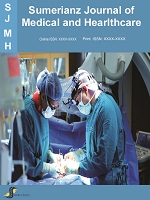Sumerianz Journal of Medical and Healthcare

Online ISSN: 2663-421X
Print ISSN: 2706-8404
Quarterly Published (4 Issues Per Year)
Journal Website: https://www.sumerianz.com/?ic=journal-home&journal=31Archive
Volume 7 Issue 1 (2024)
Evaluation of the Factors Influencing Needle stick Injury And Bloodborne Pathogens among Healthcare Workers in Benue State University Teaching Hospital Makurdi, North-Central Nigeria
Authors : Onah Emmanuel Sunday ; Ani Celestine Okafor ; Anikpo Eberechukwu Florentina ; Ejim Nnamdi Ferdinand ; Chime Pascal Uwadiegwu ; Agbo Joseph Ikenna ; Uzoigwe Soky Okaibe ; Hebatallah Ghoneim
DOI : doi.org/10.47752/sjmh.71.9.18
Abstract:It is well recognized that the danger of needle stick injuries and the blood-borne diseases they can cause is higher for healthcare professionals. In order to do this, a survey on the variables influencing blood-borne infections and needle stick injuries among medical personnel at the Benue State University Teaching Hospital (BSUTH) in Benue State, North Central Nigeria, was carried out. A descriptive cross-sectional survey was used as the methodology, and questionnaires were given to medical professionals at BSUTH in Makurdi, Benue State, including doctors, nurses, and medical laboratory scientists. Using a straightforward random sample method, the participants who fulfilled the inclusion requirements were chosen. Findings: The questionnaires were distributed to participants between the ages of 20 and 35. Of those, 190 (68.8%) were female, and 177 (64.10%) were single. The study’s findings also showed that 39% of the respondents were physicians. In addition, 74% of respondents had worked for less than five years, 13% for six to ten years, and a further 13% for ten years or more. The most reliable source of information for blood-borne infections (89.1%) and needle stick injuries (78.4%) was the Teaching Hospital. Of the 109 people who had needle stick injuries at that time, 84.4% had done so fewer than five times in the previous six months, and 4.6% had done so more than ten times. For the last six months, Tin. According to the results, 16.5% of the participants in this category suffered an intravenous insertion needle stick injury, 18.3% during an injection, and 60% while recapping a needle. Males were also found to have a greater frequency of needle stick injuries (66.3%) than females, with medical professionals and those with six to ten years of experience having the highest prevalence. However, medical lab scientists had a greater prevalence of blood-borne infections (20.7%). The outcome demonstrated negative opinions regarding blood-borne infections and needle stick injuries.
The Role of Personality and Stress in the Development of Substance Use Disorder among Substance Use Disorder Patients in Kaduna State, Nigeria
Authors : Okechukwu. J. Oguizu ; Elizabeth. A. Joshua ; Ada. D. Oguizu
DOI : doi.org/10.47752/sjmh.71.1.8
Abstract:This study investigated the role of personality and stress in the development of substance use disorder among substance use disorder patients in Kaduna State. A cross sectional design was adopted in the study and participants were 47 substance use disorder (SUD) patients (42 males and 5 females) between the ages of 18 – 40 years. They were drawn from the substance use disorder patients of Federal Neuropsychiatric Hospitals Kaduna using purposive sampling method in Kaduna. The questionnaire measures; Social and Psychological Determinants of Drug Abuse Questionnaire [1]. ‘The Big Five Inventory’ (BFI) as developed by John and Srivastava [2], Drug Abuse Screening Test (DAST-28) developed by Skinner [3] and The Life Events Inventory’ [4] were completed by the participants. Prediction for the development of drugs use was considered using neuroticism, extraversion, and openness to experience, agreeability, conscientiousness and stress. While cross-sectional design was adopted for the study. Linear Regression Analysis and Hierarchical multiple regression analysis was applied to analyze the data. Results showed that neuroticism did not significantly predict substance use disorder (R= .040; F= .072, P > .05) thus, accounted for about 0.2% variance for the substance use disorder among clients. While extraversion significantly predict substance use disorder (R= .303; F= 4.557, P < .05) thus, accounted for about 9.2% variance for the substance use disorder among clients. Openness to experience did not significantly predict substance use disorder (R= .235; F= 2.625, P > .05) thus, accounted for about 5.5% variance for the substance use disorder among clients. Agreeableness did not significantly predict substance use disorder (R= .241; F= 2.772, P > .05) thus, accounted for about 5.8% variance for the substance use disorder among clients. Also, the results indicates a no statistically significantly positive impact of agreeableness (β= .345 t= 1.665, p > .05) on substance use disorder. Conscientiousness did not significantly predict substance use disorder (R= .257; F= 3.024, P > .05) thus, accounted for about 6.3% variance for the substance use disorder among clients. Stress did not significantly predict substance use disorder (R= .020; F= .018, P > .05) thus, accounted for no variance for substance use disorder among clients. In hypothesis seven, it was shown that the first model was jointly significant F (5, 41) = 3.159, P< 0.05, R2 = 0.280. Both conscientiousness and extraversion were the significant predictors of substance use disorder. It is suggested that, clinicians treating the patients at the hospital should endeavor to assess personality factors and substance abuse disorders to ascertain their co-morbidity status and if found, should be treated for both at the same time to enhance better quality of life and reduce susceptibility to substance use disorder.



